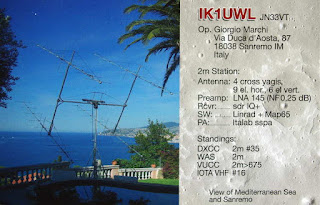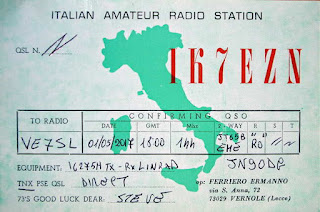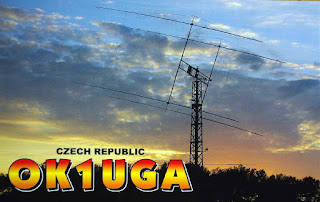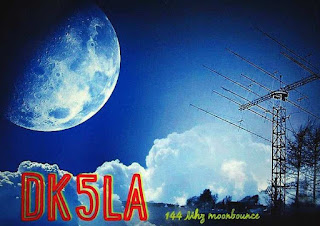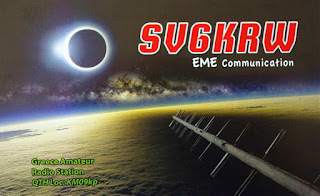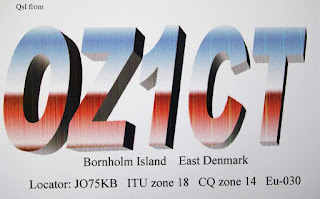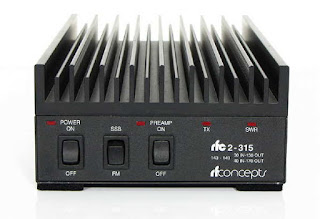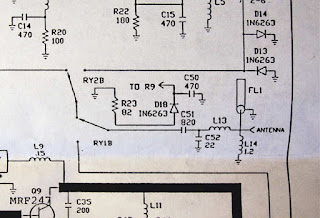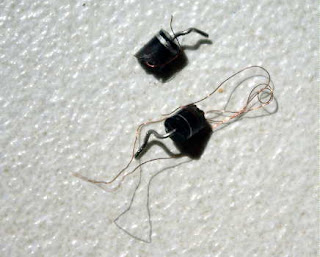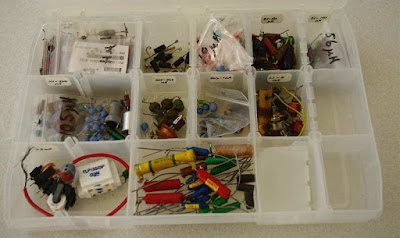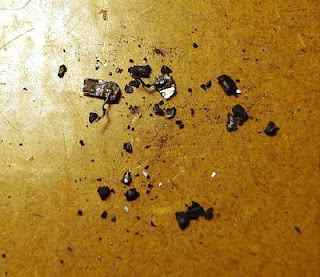Posts Tagged ‘JT65B’
 An Interesting FT8 Afternoon
An Interesting FT8 Afternoon

Lest my loyal blog-followers think I’ve taken a leap to the digital-darkside, rest assured this is not the case!
The only time that I (somewhat grudgingly) use FT8 is during the summer Es season, since most of the DX seems to have migrated to that mode. On Monday afternoon, during a moment of weakness driven by curiosity, I moved my receiver from 630m JT9 to 40m FT8 ... what might I see at around noon, via this popular weak signal digital QSO mode? To say that the results were surprising is an understatement!
 |
| 40m at noon |
With an all-daylight path between VE7 and Asia, could these signals be coming via the long-path? If so, I would expect to see at least a few signals from other countries along the great circle path to Asia but none were forthcoming. Perhaps it’s a case of there being a sufficiently weak D-layer to allow signals to propagate on the direct path via the F-layer, in spite of the all-daylight path. What do you think?
I then moved the receiver down to 80m, and monitored there for the next two hours.
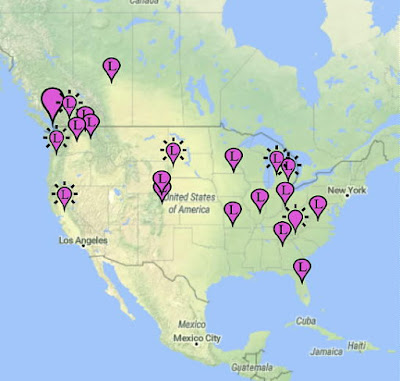 |
| 80m at 1500 local |
For both 80 and 40m, the antenna used was my 80m end-fed half-wave configured as an inverted-L ... 70’ straight up and 60’ horizontal. The feedpoint is one-foot above the ground and located beside the ocean, looking towards the east.
I then finished off the afternoon with a look on topband, using my 160m half-sloper. The screen capture of 160m was made at 5PM local time, fully two hours before my local sunset!
 |
| 160m at 1700 local |
Like the previous two bands, 160m was showing signals in broad daylight, from the east coast! Low D-layer absorption? ... salt water horizon gain? ... excellent antennas? ... or is this just the sensitivity of FT8 revealing 'normal propagation' that we can't hear on CW? I suspect that it's a complex combination of all of these factors and maybe others.
In reality, the weak-signal ‘digging power’ of FT8 is not too much greater than the threshold for audible CW ... hearing about 1 S-unit (~6-7db) deeper. Maybe that’s all it takes to peel-back, like an onion skin, another layer of hidden signals.
There are other weak-signal digital QSO modes much more sensitive than FT8. Both JT9 and JT65 can each hear more than an S-unit deeper than FT8 but at the expense of taking longer to do it ... there’s just no free-ride. I believe that the shorter (~15 second) sequencing of FT8 is the main reason for its overwhelming popularity, in spite of its lower sensitivity.
I’ll run this test again soon to see if Monday’s daytime prop was unusual or if it was typical of what to expect with weak-signal digital modes on the lower bands during the daylight hours ... either way, it was indeed, an interesting FT8 afternoon!
 July’s EME Window
July’s EME Window
 With QSLs still arriving from previous 2m EME action, I was looking extra forward to late July's very short window.
With QSLs still arriving from previous 2m EME action, I was looking extra forward to late July's very short window.When last month's activity was interrupted by my 140W brick amplifier catching fire, I was anxious to see if my repairs and homebrew RFC would still allow me to play on the moon. With July's best-positioned moonrises being too close to the sun (which was also rising at the same time), I was only able to spend a short time over two days before the moon travelled too far to the south and into my neighbour's trees.
Luckily I was rewarded with what seemed like very good lunar conditions, enabling me to easily work six different stations ... three of them being all-time new ones and boosting my EME initials total to 112.
I2FAK Franco / 16x19 el array
RK3FG Anatoly / 4x15 el array
G4SWX John / 4x16 el array
F4DJK Paul / 4x11 el array / #110
F5AQX Andre / 4x11 el array / #111
DL9DBJ Hartmut / 4x10 el array / #112
In addition, DL1VPL told me that he was able to copy me with his single 12el Yagi during the QSO with I2FAK! Needless to say, a contact between two single Yagi stations would be truly remarkable. I've only been able to copy a single Yagi station once over the years.
| F4DJK's 4x11 el array |
 | |||||
| F5AQX's 4x11 el array |
 |
| DJ9DBJ's 4x10 el array |
I was gratified to see that letting the smoke out of my little amplifier last month apparently caused no permanent damage and the repair seems to be holding up ... but I'll leave the bottom off for now just in case it gets any more crazy ideas.
 July’s EME Window
July’s EME Window
 With QSLs still arriving from previous 2m EME action, I was looking extra forward to late July's very short window.
With QSLs still arriving from previous 2m EME action, I was looking extra forward to late July's very short window.When last month's activity was interrupted by my 140W brick amplifier catching fire, I was anxious to see if my repairs and homebrew RFC would still allow me to play on the moon. With July's best-positioned moonrises being too close to the sun (which was also rising at the same time), I was only able to spend a short time over two days before the moon travelled too far to the south and into my neighbour's trees.
Luckily I was rewarded with what seemed like very good lunar conditions, enabling me to easily work six different stations ... three of them being all-time new ones and boosting my EME initials total to 112.
I2FAK Franco / 16x19 el array
RK3FG Anatoly / 4x15 el array
G4SWX John / 4x16 el array
F4DJK Paul / 4x11 el array / #110
F5AQX Andre / 4x11 el array / #111
DL9DBJ Hartmut / 4x10 el array / #112
In addition, DL1VPL told me that he was able to copy me with his single 12el Yagi during the QSO with I2FAK! Needless to say, a contact between two single Yagi stations would be truly remarkable. I've only been able to copy a single Yagi station once over the years.
| F4DJK's 4x11 el array |
 | |||||
| F5AQX's 4x11 el array |
 |
| DJ9DBJ's 4x10 el array |
I was gratified to see that letting the smoke out of my little amplifier last month apparently caused no permanent damage and the repair seems to be holding up ... but I'll leave the bottom off for now just in case it gets any more crazy ideas.
 June Moonbounce Heats Up
June Moonbounce Heats Up
Last week's favorable northern declination of the Moon allowed me two days of activity, once my moonrises had lagged far enough behind the early sunrises.
With fixed elevation and not having the ability to track the moon as it rises, I can only operate for about two hours before the moon gets too high. The highest elevation that I am able to work seems to stop near 20 degrees.
With QSLs from earlier sessions still arriving, I noted last week's activity was down somewhat from the previous month ... summertime activities usually take priority over EME for most moonbouncers.
During my two mornings of moon time I worked five stations which included two new DXCC countries, bringing my 2m DXCC total to 30. Stations worked at the end of June were:
ON4AOI #106 (new country)
OH3AWW #107 (new country)
I2RV second QSO
DK9WI #108
IK6CAK #109
Interestingly, all of the stations answered one of my CQs, with one CQ having three different callers at one time ... pretty exciting and something that I don't think has occurred here before! But that wasn't the only excitement of the week.
In the middle of a CQ following my QSO with IK6CAK, I heard a faint 'crack' sound from my amplifier, an aging RF Concepts 2-135, followed by the unmistakable whiff of a 'too hot' electronic component ... every ham is familiar with this always unwelcome odor and it usually spells trouble.
During the next CQ, I saw a trace of smoke coming out of the amp's back corner vent holes, at which point I reluctantly shut things down in the middle of some superb EME conditions.
After tearing into the amplifier, the only thing that looked stressed was a small inductor (L14 below), part of the output filtering / impedance matching circuitry.
It looked a little darker and somewhat stressed and as I gave it a poke with a screwdriver blade, it immediately disintegrated into what you see below.
It was a small (1.2uH) encapsulated RFC which appeared to be wire-wound on a core material that I did not recognize and likely suitable for VHF. I surmised that after several years of 100% duty-cycle JT65 operation, the inductor had been over-stressed to the point of failure ... helping to filter all of those nasty high frequency harmonics can't be an easy job!
After a search of my RFC collection (see below), salvaged mostly from junked TVs, monitors, VCRs and other electronic cast-offs temporarily 'borrowed' for stripping from our local recycle center here on Mayne Island, I settled on a 1.2uH choke that I hoped would be a suitable replacement. It had just a few turns so I assumed it was wound on some sort of powdered iron or ferrite form. Whether or not it would behave at 144MHz was another question.
After reassembling the amplifier the following morning, I keyed up at full power during the EME window but halfway through my initial CQ I saw smoke and then flames coming from the inside of the case ... yikes! Shutting down immediately killed the fire and after tearing into the amp yet again, I saw that this time, the output coupling capacitor (C51) had completely destroyed itself.
The new inductor (L14) appeared a little heated, but I assumed it was only smoke-damaged from the nearby flameout of the capacitor. I replaced C51, an 820pF silver mica, with a higher rated one of the same value and, once again, gave it the smoke test ... literally.
After a few seconds, a whiff of smoke appeared from the back of the amp, followed by the SWR trip-out kicking in and shutting the amp down.
This time it appeared that the inductor was definitely complicit in the destruction of the capacitor as it was charred and black. I surmised that whatever core material the little inductor was wound upon, definitely was not suitable at 144MHz and had caused the little inductor to either change value or to saturate ... whatever it was doing had created a highly reactive condition in the output circuit, changing the output load impedance and sending the SWR sky-high.
This time I replaced the inductor with a homebrew one, wound on a plain phenolic former, hoping to avoid any ferro-magnetic / frequency compatibility issues. After reassembling the amplifier, it seemed to be happy once again and ran nicely for several 60 second JT65B sequences at full power with no smoke or component heating!
By this time I had run out of favorable EME windows as my moonrises were now too far to the south to keep me away from the neighbour's trees ... I'll just have to be patient and wait until the end of the month for the next definitive test. Let's hope there's no more smoke.
With fixed elevation and not having the ability to track the moon as it rises, I can only operate for about two hours before the moon gets too high. The highest elevation that I am able to work seems to stop near 20 degrees.
With QSLs from earlier sessions still arriving, I noted last week's activity was down somewhat from the previous month ... summertime activities usually take priority over EME for most moonbouncers.
During my two mornings of moon time I worked five stations which included two new DXCC countries, bringing my 2m DXCC total to 30. Stations worked at the end of June were:
ON4AOI #106 (new country)
OH3AWW #107 (new country)
I2RV second QSO
DK9WI #108
IK6CAK #109
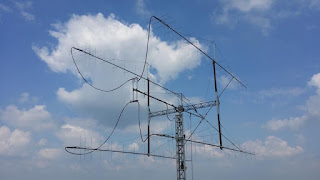 |
| ON4AOI - 4 X 14V / 14H array |
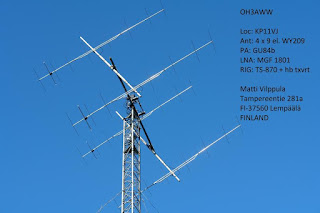 |
| OH3AWW - 4 X 9el array |
 |
| IK6CAK - 9H / 6V 8el LFA array more |
In the middle of a CQ following my QSO with IK6CAK, I heard a faint 'crack' sound from my amplifier, an aging RF Concepts 2-135, followed by the unmistakable whiff of a 'too hot' electronic component ... every ham is familiar with this always unwelcome odor and it usually spells trouble.
During the next CQ, I saw a trace of smoke coming out of the amp's back corner vent holes, at which point I reluctantly shut things down in the middle of some superb EME conditions.
After tearing into the amplifier, the only thing that looked stressed was a small inductor (L14 below), part of the output filtering / impedance matching circuitry.
It looked a little darker and somewhat stressed and as I gave it a poke with a screwdriver blade, it immediately disintegrated into what you see below.
It was a small (1.2uH) encapsulated RFC which appeared to be wire-wound on a core material that I did not recognize and likely suitable for VHF. I surmised that after several years of 100% duty-cycle JT65 operation, the inductor had been over-stressed to the point of failure ... helping to filter all of those nasty high frequency harmonics can't be an easy job!
After a search of my RFC collection (see below), salvaged mostly from junked TVs, monitors, VCRs and other electronic cast-offs temporarily 'borrowed' for stripping from our local recycle center here on Mayne Island, I settled on a 1.2uH choke that I hoped would be a suitable replacement. It had just a few turns so I assumed it was wound on some sort of powdered iron or ferrite form. Whether or not it would behave at 144MHz was another question.
After reassembling the amplifier the following morning, I keyed up at full power during the EME window but halfway through my initial CQ I saw smoke and then flames coming from the inside of the case ... yikes! Shutting down immediately killed the fire and after tearing into the amp yet again, I saw that this time, the output coupling capacitor (C51) had completely destroyed itself.
The new inductor (L14) appeared a little heated, but I assumed it was only smoke-damaged from the nearby flameout of the capacitor. I replaced C51, an 820pF silver mica, with a higher rated one of the same value and, once again, gave it the smoke test ... literally.
After a few seconds, a whiff of smoke appeared from the back of the amp, followed by the SWR trip-out kicking in and shutting the amp down.
This time it appeared that the inductor was definitely complicit in the destruction of the capacitor as it was charred and black. I surmised that whatever core material the little inductor was wound upon, definitely was not suitable at 144MHz and had caused the little inductor to either change value or to saturate ... whatever it was doing had created a highly reactive condition in the output circuit, changing the output load impedance and sending the SWR sky-high.
This time I replaced the inductor with a homebrew one, wound on a plain phenolic former, hoping to avoid any ferro-magnetic / frequency compatibility issues. After reassembling the amplifier, it seemed to be happy once again and ran nicely for several 60 second JT65B sequences at full power with no smoke or component heating!
By this time I had run out of favorable EME windows as my moonrises were now too far to the south to keep me away from the neighbour's trees ... I'll just have to be patient and wait until the end of the month for the next definitive test. Let's hope there's no more smoke.
 June Moonbounce Heats Up
June Moonbounce Heats Up
Last week's favorable northern declination of the Moon allowed me two days of activity, once my moonrises had lagged far enough behind the early sunrises.
With fixed elevation and not having the ability to track the moon as it rises, I can only operate for about two hours before the moon gets too high. The highest elevation that I am able to work seems to stop near 20 degrees.
With QSLs from earlier sessions still arriving, I noted last week's activity was down somewhat from the previous month ... summertime activities usually take priority over EME for most moonbouncers.
During my two mornings of moon time I worked five stations which included two new DXCC countries, bringing my 2m DXCC total to 30. Stations worked at the end of June were:
ON4AOI #106 (new country)
OH3AWW #107 (new country)
I2RV second QSO
DK9WI #108
IK6CAK #109
Interestingly, all of the stations answered one of my CQs, with one CQ having three different callers at one time ... pretty exciting and something that I don't think has occurred here before! But that wasn't the only excitement of the week.
In the middle of a CQ following my QSO with IK6CAK, I heard a faint 'crack' sound from my amplifier, an aging RF Concepts 2-135, followed by the unmistakable whiff of a 'too hot' electronic component ... every ham is familiar with this always unwelcome odor and it usually spells trouble.
During the next CQ, I saw a trace of smoke coming out of the amp's back corner vent holes, at which point I reluctantly shut things down in the middle of some superb EME conditions.
After tearing into the amplifier, the only thing that looked stressed was a small inductor (L14 below), part of the output filtering / impedance matching circuitry.
It looked a little darker and somewhat stressed and as I gave it a poke with a screwdriver blade, it immediately disintegrated into what you see below.
It was a small (1.2uH) encapsulated RFC which appeared to be wire-wound on a core material that I did not recognize and likely suitable for VHF. I surmised that after several years of 100% duty-cycle JT65 operation, the inductor had been over-stressed to the point of failure ... helping to filter all of those nasty high frequency harmonics can't be an easy job!
After a search of my RFC collection (see below), salvaged mostly from junked TVs, monitors, VCRs and other electronic cast-offs temporarily 'borrowed' for stripping from our local recycle center here on Mayne Island, I settled on a 1.2uH choke that I hoped would be a suitable replacement. It had just a few turns so I assumed it was wound on some sort of powdered iron or ferrite form. Whether or not it would behave at 144MHz was another question.
After reassembling the amplifier the following morning, I keyed up at full power during the EME window but halfway through my initial CQ I saw smoke and then flames coming from the inside of the case ... yikes! Shutting down immediately killed the fire and after tearing into the amp yet again, I saw that this time, the output coupling capacitor (C51) had completely destroyed itself.
The new inductor (L14) appeared a little heated, but I assumed it was only smoke-damaged from the nearby flameout of the capacitor. I replaced C51, an 820pF silver mica, with a higher rated one of the same value and, once again, gave it the smoke test ... literally.
After a few seconds, a whiff of smoke appeared from the back of the amp, followed by the SWR trip-out kicking in and shutting the amp down.
This time it appeared that the inductor was definitely complicit in the destruction of the capacitor as it was charred and black. I surmised that whatever core material the little inductor was wound upon, definitely was not suitable at 144MHz and had caused the little inductor to either change value or to saturate ... whatever it was doing had created a highly reactive condition in the output circuit, changing the output load impedance and sending the SWR sky-high.
This time I replaced the inductor with a homebrew one, wound on a plain phenolic former, hoping to avoid any ferro-magnetic / frequency compatibility issues. After reassembling the amplifier, it seemed to be happy once again and ran nicely for several 60 second JT65B sequences at full power with no smoke or component heating!
By this time I had run out of favorable EME windows as my moonrises were now too far to the south to keep me away from the neighbour's trees ... I'll just have to be patient and wait until the end of the month for the next definitive test. Let's hope there's no more smoke.
With fixed elevation and not having the ability to track the moon as it rises, I can only operate for about two hours before the moon gets too high. The highest elevation that I am able to work seems to stop near 20 degrees.
With QSLs from earlier sessions still arriving, I noted last week's activity was down somewhat from the previous month ... summertime activities usually take priority over EME for most moonbouncers.
During my two mornings of moon time I worked five stations which included two new DXCC countries, bringing my 2m DXCC total to 30. Stations worked at the end of June were:
ON4AOI #106 (new country)
OH3AWW #107 (new country)
I2RV second QSO
DK9WI #108
IK6CAK #109
 |
| ON4AOI - 4 X 14V / 14H array |
 |
| OH3AWW - 4 X 9el array |
 |
| IK6CAK - 9H / 6V 8el LFA array more |
In the middle of a CQ following my QSO with IK6CAK, I heard a faint 'crack' sound from my amplifier, an aging RF Concepts 2-135, followed by the unmistakable whiff of a 'too hot' electronic component ... every ham is familiar with this always unwelcome odor and it usually spells trouble.
During the next CQ, I saw a trace of smoke coming out of the amp's back corner vent holes, at which point I reluctantly shut things down in the middle of some superb EME conditions.
After tearing into the amplifier, the only thing that looked stressed was a small inductor (L14 below), part of the output filtering / impedance matching circuitry.
It looked a little darker and somewhat stressed and as I gave it a poke with a screwdriver blade, it immediately disintegrated into what you see below.
It was a small (1.2uH) encapsulated RFC which appeared to be wire-wound on a core material that I did not recognize and likely suitable for VHF. I surmised that after several years of 100% duty-cycle JT65 operation, the inductor had been over-stressed to the point of failure ... helping to filter all of those nasty high frequency harmonics can't be an easy job!
After a search of my RFC collection (see below), salvaged mostly from junked TVs, monitors, VCRs and other electronic cast-offs temporarily 'borrowed' for stripping from our local recycle center here on Mayne Island, I settled on a 1.2uH choke that I hoped would be a suitable replacement. It had just a few turns so I assumed it was wound on some sort of powdered iron or ferrite form. Whether or not it would behave at 144MHz was another question.
After reassembling the amplifier the following morning, I keyed up at full power during the EME window but halfway through my initial CQ I saw smoke and then flames coming from the inside of the case ... yikes! Shutting down immediately killed the fire and after tearing into the amp yet again, I saw that this time, the output coupling capacitor (C51) had completely destroyed itself.
The new inductor (L14) appeared a little heated, but I assumed it was only smoke-damaged from the nearby flameout of the capacitor. I replaced C51, an 820pF silver mica, with a higher rated one of the same value and, once again, gave it the smoke test ... literally.
After a few seconds, a whiff of smoke appeared from the back of the amp, followed by the SWR trip-out kicking in and shutting the amp down.
This time it appeared that the inductor was definitely complicit in the destruction of the capacitor as it was charred and black. I surmised that whatever core material the little inductor was wound upon, definitely was not suitable at 144MHz and had caused the little inductor to either change value or to saturate ... whatever it was doing had created a highly reactive condition in the output circuit, changing the output load impedance and sending the SWR sky-high.
This time I replaced the inductor with a homebrew one, wound on a plain phenolic former, hoping to avoid any ferro-magnetic / frequency compatibility issues. After reassembling the amplifier, it seemed to be happy once again and ran nicely for several 60 second JT65B sequences at full power with no smoke or component heating!
By this time I had run out of favorable EME windows as my moonrises were now too far to the south to keep me away from the neighbour's trees ... I'll just have to be patient and wait until the end of the month for the next definitive test. Let's hope there's no more smoke.
 May’s ‘Red Ryder’ EME Ops
May’s ‘Red Ryder’ EME Ops
There still seems to be a number of 'big guns' showing up each month, that I have not heard or worked before as well as several 2-Yagi 'little pistols' that I am able to work under very good lunar path conditions. I suspect that having just 1-Yagi puts me in the $2.95 'Red Ryder' category!

With the QSL's from last month's surprisingly good EME conditions just starting to arrive, May's moonbounce operation continued to produce good results.
Whether this is because of better than normal lunar path conditions or just a result of my neighbour's tree-pruning, remains to be seen.
The few days of operating in early May were, as usual, planned to take advantage of the Moon's closest approach as well as the Moon's most northerly declinations. The latter condition puts moonrises directly out in front of the house and looking across Georgia Strait's many miles of saltwater. The extra theoretical 'sea-gain' appears to be a reality under these conditions and allows my 9el Yagi to garner another 6db on both transmit and receive paths, making it perform more like a '4-Yagi' array.
Eight stations were worked this time around, with six of them being new 'initials', bringing my EME total from 95 to 101. Several of these stations were speaker-audible, at CW levels.
NTØV #96
IK7EZN #97
EA2AGZ #98
G4SWX
F6HVK #99
G4CDN #100
DK5LA #101
DK3BU
For now, any earlier thoughts of building a 4CX250 300 watt amplifier have been put on hold, while I continue to slowly work my way through what seems a never-ending list of workable stations.

With the QSL's from last month's surprisingly good EME conditions just starting to arrive, May's moonbounce operation continued to produce good results.
Whether this is because of better than normal lunar path conditions or just a result of my neighbour's tree-pruning, remains to be seen.
The few days of operating in early May were, as usual, planned to take advantage of the Moon's closest approach as well as the Moon's most northerly declinations. The latter condition puts moonrises directly out in front of the house and looking across Georgia Strait's many miles of saltwater. The extra theoretical 'sea-gain' appears to be a reality under these conditions and allows my 9el Yagi to garner another 6db on both transmit and receive paths, making it perform more like a '4-Yagi' array.
Eight stations were worked this time around, with six of them being new 'initials', bringing my EME total from 95 to 101. Several of these stations were speaker-audible, at CW levels.
NTØV #96
IK7EZN #97
EA2AGZ #98
G4SWX
F6HVK #99
G4CDN #100
DK5LA #101
DK3BU
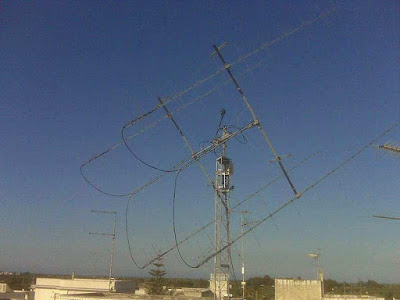 | ||||
| IK7EZN's cross polarized 4 x 13 array |
 |
| EA2AGZ's 4 x 16 array |
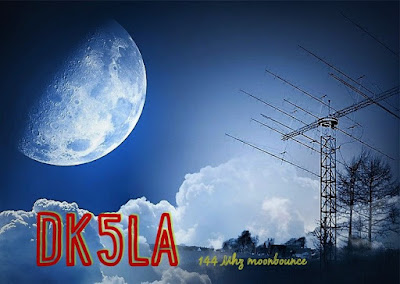 |
| DK5LA's cross polarized 8 x 16 array ...very loud! |
For now, any earlier thoughts of building a 4CX250 300 watt amplifier have been put on hold, while I continue to slowly work my way through what seems a never-ending list of workable stations.
 May’s ‘Red Ryder’ EME Ops
May’s ‘Red Ryder’ EME Ops
There still seems to be a number of 'big guns' showing up each month, that I have not heard or worked before as well as several 2-Yagi 'little pistols' that I am able to work under very good lunar path conditions. I suspect that having just 1-Yagi puts me in the $2.95 'Red Ryder' category!

With the QSL's from last month's surprisingly good EME conditions just starting to arrive, May's moonbounce operation continued to produce good results.
Whether this is because of better than normal lunar path conditions or just a result of my neighbour's tree-pruning, remains to be seen.
The few days of operating in early May were, as usual, planned to take advantage of the Moon's closest approach as well as the Moon's most northerly declinations. The latter condition puts moonrises directly out in front of the house and looking across Georgia Strait's many miles of saltwater. The extra theoretical 'sea-gain' appears to be a reality under these conditions and allows my 9el Yagi to garner another 6db on both transmit and receive paths, making it perform more like a '4-Yagi' array.
Eight stations were worked this time around, with six of them being new 'initials', bringing my EME total from 95 to 101. Several of these stations were speaker-audible, at CW levels.
NTØV #96
IK7EZN #97
EA2AGZ #98
G4SWX
F6HVK #99
G4CDN #100
DK5LA #101
DK3BU
For now, any earlier thoughts of building a 4CX250 300 watt amplifier have been put on hold, while I continue to slowly work my way through what seems a never-ending list of workable stations.

With the QSL's from last month's surprisingly good EME conditions just starting to arrive, May's moonbounce operation continued to produce good results.
Whether this is because of better than normal lunar path conditions or just a result of my neighbour's tree-pruning, remains to be seen.
The few days of operating in early May were, as usual, planned to take advantage of the Moon's closest approach as well as the Moon's most northerly declinations. The latter condition puts moonrises directly out in front of the house and looking across Georgia Strait's many miles of saltwater. The extra theoretical 'sea-gain' appears to be a reality under these conditions and allows my 9el Yagi to garner another 6db on both transmit and receive paths, making it perform more like a '4-Yagi' array.
Eight stations were worked this time around, with six of them being new 'initials', bringing my EME total from 95 to 101. Several of these stations were speaker-audible, at CW levels.
NTØV #96
IK7EZN #97
EA2AGZ #98
G4SWX
F6HVK #99
G4CDN #100
DK5LA #101
DK3BU
 | ||||
| IK7EZN's cross polarized 4 x 13 array |
 |
| EA2AGZ's 4 x 16 array |
 |
| DK5LA's cross polarized 8 x 16 array ...very loud! |
For now, any earlier thoughts of building a 4CX250 300 watt amplifier have been put on hold, while I continue to slowly work my way through what seems a never-ending list of workable stations.


